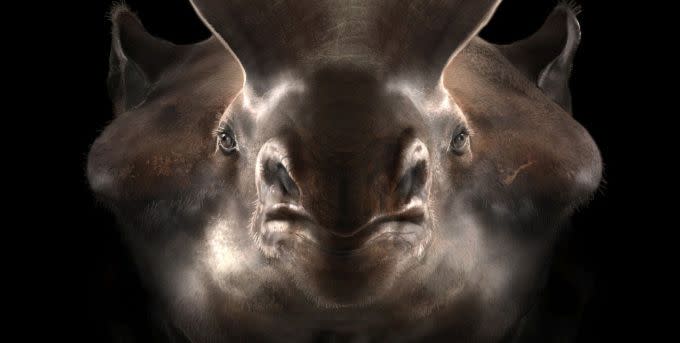New Evidence Reveals The Incredible Existence Of Ancient Thunder Beasts

The fossil record is filled with with land animals who grew to impossibly large sizes.
Brontotheres, the ancient North American ancestors of the horse, is a giantism outlier as—growing from around 40 pounds to four to five tons in 16 million years.
Studying 276 individuals in the brontotheres, researchers found that decreased competition among larger mammals led to the rise of giant “thunder beasts.”
At the end of the Triassic period, small-sized dinosaurs roamed Earth alongside other groups of archosaurs—that is, until a widespread extinction event cleared the way for dinos to put on some serious size. Then, after the dinosaurs’ own demise (the asteroid-sized curtain call known as the K-T Extinction), it became mammals’ turn to become the world’s new terrestrial giants.
The existence of mammals during the Age of Dinosaurs was one of prey—as small, squirrel-like creatures that scurried among the feet of lumbering giants. Surviving the fiery end of the Cretaceous period in their burrows, mammals quickly inherited a (non-avian) dino-free planet known as the Cenozoic period, and scientists say they wasted no time taking advantage.
One of the first animals to put on some size was a rhino-like ancestor of the horse known as brontotheres, which lived around 56 million years ago until the close of the Eocene (34 million years ago). Starting out at around 40 pounds, scientists estimate that this “thunder beast” grew up to four or five tons in only 16 million years—a blink of an eye for a planet some 4.6 billion years old. Of the nearly 60 known species of brontothere, more than half weighed over a metric ton.
With fossils found in North America, these ancient mammals get their imposing moniker from a legend of the Sioux nation. The legend tells of thunder horses that stampeded across the plains during thunderstorms.
There are three existing theories about how these creatures grew to such enormous proportions. Either they slowly swelled in size due to natural selection, grew in growth spurts followed by a plateau periods, or various species grew into varying sizes and the larger ones outlasting their smaller relatives.
After studying 276 individuals in the brontothere family to determine the most likely scenario, researchers from the Global Change Ecology and Evolution Research Group at the University of Alcalá in Spain concluded that the final explanation most likely contributed to the explosive growth of the brontotheres. This means a species of brontothere stayed the same size until it branched into different species—some bigger, some smaller. However, over time, the larger species survived where smaller brethren did not.
“It’s a more complex evolutionary world than what pure Darwinism would tell us,” Juan Cantalapiedra, a co-author on the study and paleobiologist of the University of Alcalá in Madrid told Science News. “It’s not this organized, predictable world where progress is a thing in nature and the better adapted always ended up surviving.”
The study’s lead author, Oscar Sanisidro, expects that as these “thunder beasts” grew in size, they faced less competition for food, as the Earth was still full of smaller mammal species at the time. So, while smaller species struggled over the same resources, larger ones face little to no competition. While this model only applies to North America’s ancient horse ancestors, the researchers hope to use similar methods to uncover the giant-sized lineage of other mammals.
The rules of life on Earth are always changing, but for the “thunder beast” during the first act of the Cenozoic, the mammalian game plan was simple—go big or go home.
You Might Also Like

